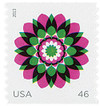
# 4724 - 2013 46c Kaleidoscope Flowers: Violet and Green
U.S. # 4724
2013 46¢ Red-Violet
Kaleidoscope Flowers
Much like snowflakes, no two kaleidoscopes are exactly the same. Everything from the angle of the mirrors to the random movement of the colored objects inside means each turn of a kaleidoscope provides a new and different view.
Kaleidoscopes are made by joining two or more mirrors (or other reflective surfaces) at an angle to each other, usually in a V-shape or triangle. The mirrors are housed in a tuberocase, which looks like a spyglass. Colored objects are then placed at one end of the mirrors and an eyehole at the other end. These colored objects can include everyday items such as buttons, beads, ribbon, flowers, or liquids.
Two-mirror kaleidoscopes create a pattern on a solid black background, while three mirrors create a pattern that fills the entire view. Depending on placement, four mirrors create a horizontal strip or a pair of identical designs. The variations continue with each change in the angle of the mirrors. Mirrors set at 60 degrees create patterns of six regular sectors, while a 45-degree angle makes eight equal sectors. The mirrors multiply the lines and colors of the objects inside, and changes continue as the kaleidoscope is rotated. The possibilities are endless, especially as modern artists find new objects and new ways to construct kaleidoscopes, making it a true art form.
Art director Antonio Alcalá designed the Kaleidoscope Flower stamps using the art of graphic artists Petra and Nicole Kapitza. Each stamp pictures the same flower shape with different colors, creating the illusion that the patterns recede or move forward.
Value: 46¢ first class letter rate
Issued: January 14, 2013
First Day City: Kansas City, MO
Type of Stamp: Definitive
Printed by: Banknote Corporation of America for Sennett Security Products
Method: Offset printing in coils of 3,000 and 10,000
Perforation: Serpentine Die Cut 11
Self-Adhesive
Quantity Printed: 42,500,000 stamps
The Kaleidoscope Flower stamps continue the U.S.P.S. tradition of picturing beautiful flowers on postage. These stamps were issued in large coils for use by businesses that send large amounts of first-class letters.
U.S. # 4724
2013 46¢ Red-Violet
Kaleidoscope Flowers
Much like snowflakes, no two kaleidoscopes are exactly the same. Everything from the angle of the mirrors to the random movement of the colored objects inside means each turn of a kaleidoscope provides a new and different view.
Kaleidoscopes are made by joining two or more mirrors (or other reflective surfaces) at an angle to each other, usually in a V-shape or triangle. The mirrors are housed in a tuberocase, which looks like a spyglass. Colored objects are then placed at one end of the mirrors and an eyehole at the other end. These colored objects can include everyday items such as buttons, beads, ribbon, flowers, or liquids.
Two-mirror kaleidoscopes create a pattern on a solid black background, while three mirrors create a pattern that fills the entire view. Depending on placement, four mirrors create a horizontal strip or a pair of identical designs. The variations continue with each change in the angle of the mirrors. Mirrors set at 60 degrees create patterns of six regular sectors, while a 45-degree angle makes eight equal sectors. The mirrors multiply the lines and colors of the objects inside, and changes continue as the kaleidoscope is rotated. The possibilities are endless, especially as modern artists find new objects and new ways to construct kaleidoscopes, making it a true art form.
Art director Antonio Alcalá designed the Kaleidoscope Flower stamps using the art of graphic artists Petra and Nicole Kapitza. Each stamp pictures the same flower shape with different colors, creating the illusion that the patterns recede or move forward.
Value: 46¢ first class letter rate
Issued: January 14, 2013
First Day City: Kansas City, MO
Type of Stamp: Definitive
Printed by: Banknote Corporation of America for Sennett Security Products
Method: Offset printing in coils of 3,000 and 10,000
Perforation: Serpentine Die Cut 11
Self-Adhesive
Quantity Printed: 42,500,000 stamps
The Kaleidoscope Flower stamps continue the U.S.P.S. tradition of picturing beautiful flowers on postage. These stamps were issued in large coils for use by businesses that send large amounts of first-class letters.









